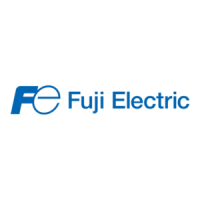Do you have a question about the Fuji Electric BW32AAG and is the answer not in the manual?
Outlines common low-voltage circuit faults and the necessity of protection devices.
Details overcurrent faults, their causes, and the role of circuit breakers in protection.
Explains phase-loss faults in three-phase circuits and their prevention methods.
Covers types of overcurrent tripping (inverse-time, instantaneous, short-time) and influencing factors.
Details short-circuit current breaking, including capacity, let-through current, and arc space.
Describes overload switching test conditions and performance criteria based on IEC standards.
Discusses temperature rise and internal resistance/power consumption at rated current.
Covers switching durability and trip switching durability requirements for MCCBs.
Details power frequency and impulse withstand voltage test criteria for breakers.
Presents data on handle operating force and angles for various MCCB types.
Lists essential factors for selecting MCCBs, covering power supply, location, installation, and application.
Explains cascade (backup) trip coordination for cost-effective protection and system reliability.
Details selective trip coordination methods between MCCBs and with high-voltage fuses.
Covers methods for protecting electrical wiring from overcurrents based on thermal characteristics.
Discusses MCCB selection for motor circuits, including protection against starting currents.
Addresses inrush current during transformer excitation and MCCB selection for primary circuits.
Explains characteristics of arc and resistance welder circuits and MCCB selection criteria.
Details arc reignition, transient inrush current, and MCCB selection for capacitor circuits.
Discusses faults, overcurrents, and protection strategies for semiconductor circuits using MCCBs.
Covers protection of Solid-State Contactors (SSCs) for heater and motor circuits using MCCBs or MMSs.
Explains how to protect inverter circuits with MCCBs, considering DC reactor usage.
Addresses MCCB suitability and derating for 400Hz circuits due to skin effect and trip variations.
Details MCCB usage in DC circuits, operating characteristic changes, and dedicated DC breakers.
Provides guidance on selecting MCCBs for UPS systems, considering overload withstand and input/output capacity.
Lists MCCB types suitable for servo amplifier applications, focusing on power supply switching and protection.
Explains grounding methods (TN, TT, IT) and ground fault protection strategies in electrical systems.
Lists standard operating conditions for MCCBs (temperature, humidity, altitude, pollution) as per IEC 60947-1.
Covers MCCB performance and precautions for high-temperature, high-humidity, cold, and high-altitude environments.
Details important precautions for connecting MCCBs, including reversed connection and tightening torque.
Explains how transient inrush currents can cause MCCB malfunctions and methods for prevention.
Provides a troubleshooting guide for common MCCB faults, including possible causes and countermeasures.
Outlines initial and periodic inspection procedures, criteria, and standards for MCCBs.
Offers guidelines for MCCB deterioration diagnosis and replacement based on durability and operating conditions.
Explains the objective, formulas, and methods for calculating short-circuit current for system design.
Outlines common low-voltage circuit faults and the necessity of protection devices.
Details overcurrent faults, their causes, and the role of circuit breakers in protection.
Explains phase-loss faults in three-phase circuits and their prevention methods.
Covers types of overcurrent tripping (inverse-time, instantaneous, short-time) and influencing factors.
Details short-circuit current breaking, including capacity, let-through current, and arc space.
Describes overload switching test conditions and performance criteria based on IEC standards.
Discusses temperature rise and internal resistance/power consumption at rated current.
Covers switching durability and trip switching durability requirements for MCCBs.
Details power frequency and impulse withstand voltage test criteria for breakers.
Presents data on handle operating force and angles for various MCCB types.
Lists essential factors for selecting MCCBs, covering power supply, location, installation, and application.
Explains cascade (backup) trip coordination for cost-effective protection and system reliability.
Details selective trip coordination methods between MCCBs and with high-voltage fuses.
Covers methods for protecting electrical wiring from overcurrents based on thermal characteristics.
Discusses MCCB selection for motor circuits, including protection against starting currents.
Addresses inrush current during transformer excitation and MCCB selection for primary circuits.
Explains characteristics of arc and resistance welder circuits and MCCB selection criteria.
Details arc reignition, transient inrush current, and MCCB selection for capacitor circuits.
Discusses faults, overcurrents, and protection strategies for semiconductor circuits using MCCBs.
Covers protection of Solid-State Contactors (SSCs) for heater and motor circuits using MCCBs or MMSs.
Explains how to protect inverter circuits with MCCBs, considering DC reactor usage.
Addresses MCCB suitability and derating for 400Hz circuits due to skin effect and trip variations.
Details MCCB usage in DC circuits, operating characteristic changes, and dedicated DC breakers.
Provides guidance on selecting MCCBs for UPS systems, considering overload withstand and input/output capacity.
Lists MCCB types suitable for servo amplifier applications, focusing on power supply switching and protection.
Explains grounding methods (TN, TT, IT) and ground fault protection strategies in electrical systems.
Lists standard operating conditions for MCCBs (temperature, humidity, altitude, pollution) as per IEC 60947-1.
Covers MCCB performance and precautions for high-temperature, high-humidity, cold, and high-altitude environments.
Details important precautions for connecting MCCBs, including reversed connection and tightening torque.
Explains how transient inrush currents can cause MCCB malfunctions and methods for prevention.
Provides a troubleshooting guide for common MCCB faults, including possible causes and countermeasures.
Outlines initial and periodic inspection procedures, criteria, and standards for MCCBs.
Offers guidelines for MCCB deterioration diagnosis and replacement based on durability and operating conditions.
Explains the objective, formulas, and methods for calculating short-circuit current for system design.
| Poles | 3 |
|---|---|
| Rated Current | 32A |
| Rated Voltage | 415VAC |
| Mounting Type | DIN Rail |
| Number of Poles | 3 |
| Trip Characteristic | B |
| Standards | IEC |










